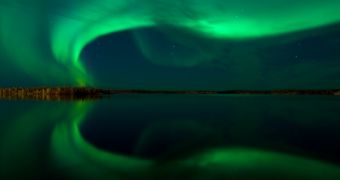What better evidence for the coming of spring than the appearance of the aurora borealis, or most commonly known as the northern lights? Well, at least astrologically speaking, in the context of ever wobbling clime. For some unknown reason, it seems that the aurora borealis phenomenon takes place only during the spring time, or in the weeks around the vernal equinox.
One thing is for certain though, aurora borealis is determined by the solar wind interacting with the Earth's atmosphere which emits light in the optical frequencies of the electromagnetic spectrum. But the question still remains valid, why during spring? The Sun's activity and the solar wind cannot be influenced by slight changes in Earth's tilt. Even more mysterious is the fact that, sometimes, aurora borealis appears abruptly, without any apparent reason.
Physicist Vassilis Angelopoulos from the University of California Los Angeles has been trying over the last years to resolve part of these mysteries, with the help of data provided by NASA THEMIS spacecrafts. THEMIS stands for Time History of Events and Macroscale Interactions during Substorms and consists of a fleet of five spacecrafts.
They may look like harmless beautiful lights in the sky, but aurora borealis actually announces a more violent phenomenon which takes place into Earth's atmosphere. The polar regions of the planet are bombarded routinely with high levels of intense radiation coming from the Sun and interstellar space. Just one electromagnetic sub-storm bursting suddenly into Earth's high atmosphere, could release enough energy, in the form of electromagnetic pulses, to knock out or damage some satellites orbiting around our planet, or even produce disturbances in radio communications and power grids. In fact, all electrical and electronic devices are affected by geomagnetic storms.
Such a geomagnetic storm occurring on 13th of March 1989, left more than 6 million people in Canada without electrical power for 9 hours. The THEMIS program was launched by NASA in the early days of 2007 and, since then, has observed storms that packed energy as high as five hundred thousand billion Joules, enough to determine an earthquake of 5.5 degrees on the Richter scale.
During the occurrence of the storm, THEMIS satellites have detected what could be the cause of the sudden and preferential appearance of geomagnetic storms. It seems that magnetic lines originating from Earth rise high above the atmosphere and into space only to collect the solar wind passing through the respective area, suppling it with enough energy to produce extremely powerful geomagnetic storms and aurora borealis phenomenons.
Dava Sibeck, from NASA's Goddard Space Center, reveals that these magnetic fields twist around each other much in the same way as rope fibers are twisted into one string, thus creating an organized structure spinning highly energetic electrically charged particles into a downwards motion towards the surface of the Earth. Further still, some magnetic fields extend and connect all the way to the Sun and appear to experience enhanced strength during springtime, as the north pole starts tilting back to the Sun.
As this phenomenon takes place during the vernal equinox, it would lead us to believe that it should also take place during the autumnal equinox. The fact is that, during the autumnal equinox, the geomagnetic activity nearly doubles, however it is not accompanied by the appearance of auroras. The THEMIS mission will continue to explore Earth's magnetosphere in its final year of mission, in the hope that scientists will be able to determine the optimal orbit for the appearance of geomagnetic storms, to predict their appearance in the near future.

 14 DAY TRIAL //
14 DAY TRIAL //